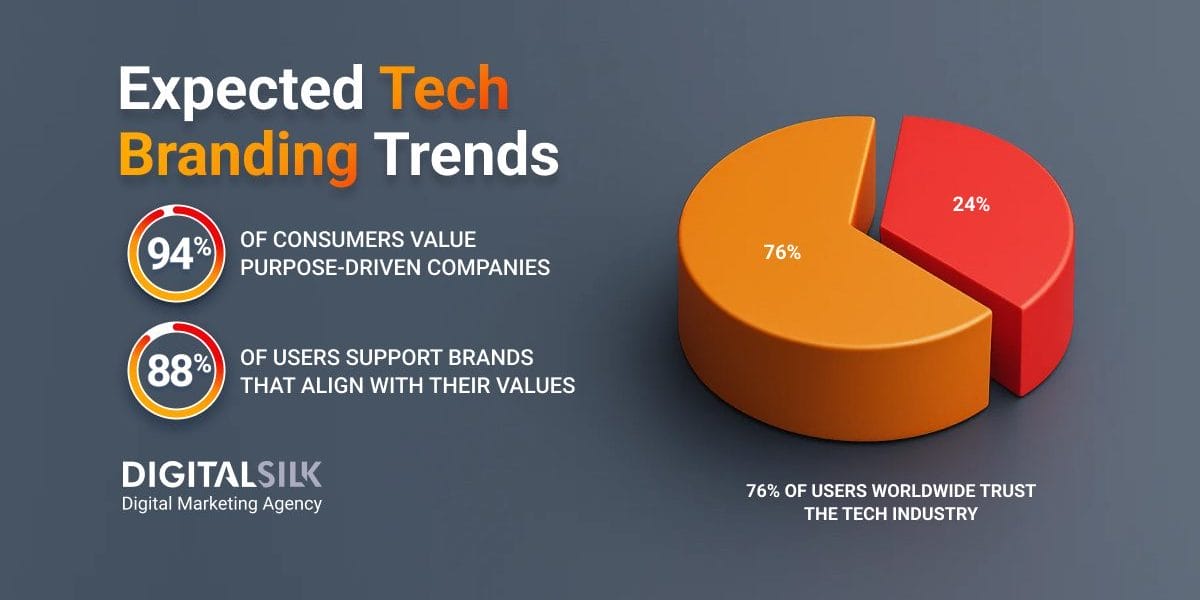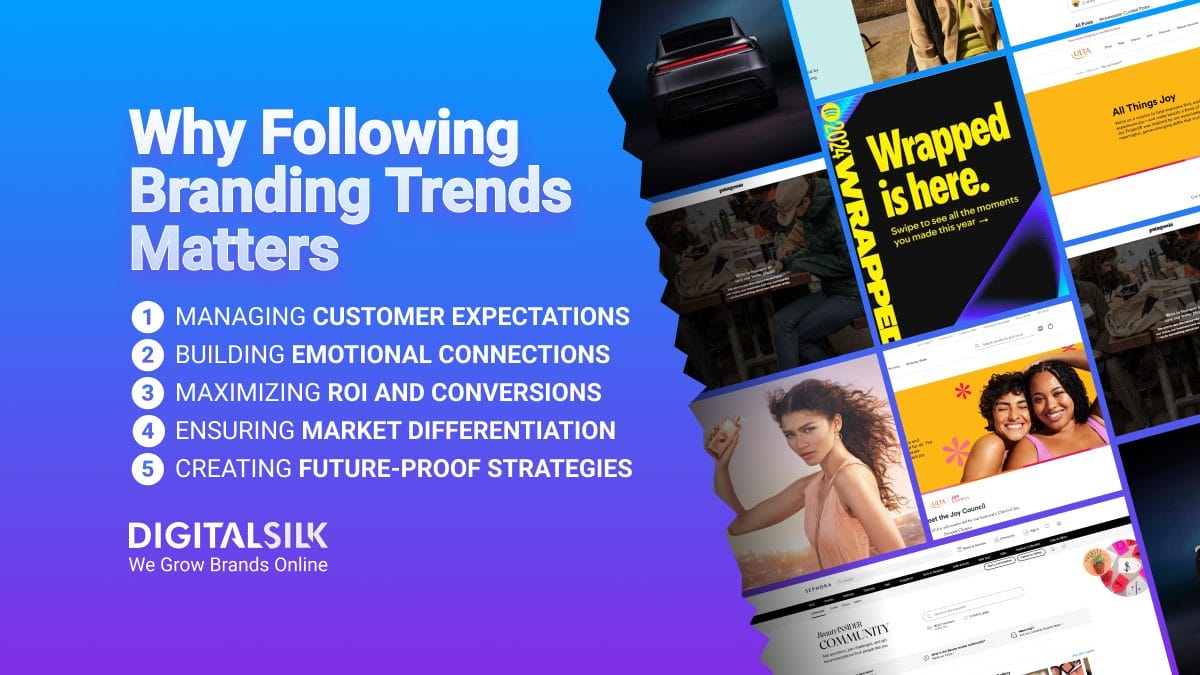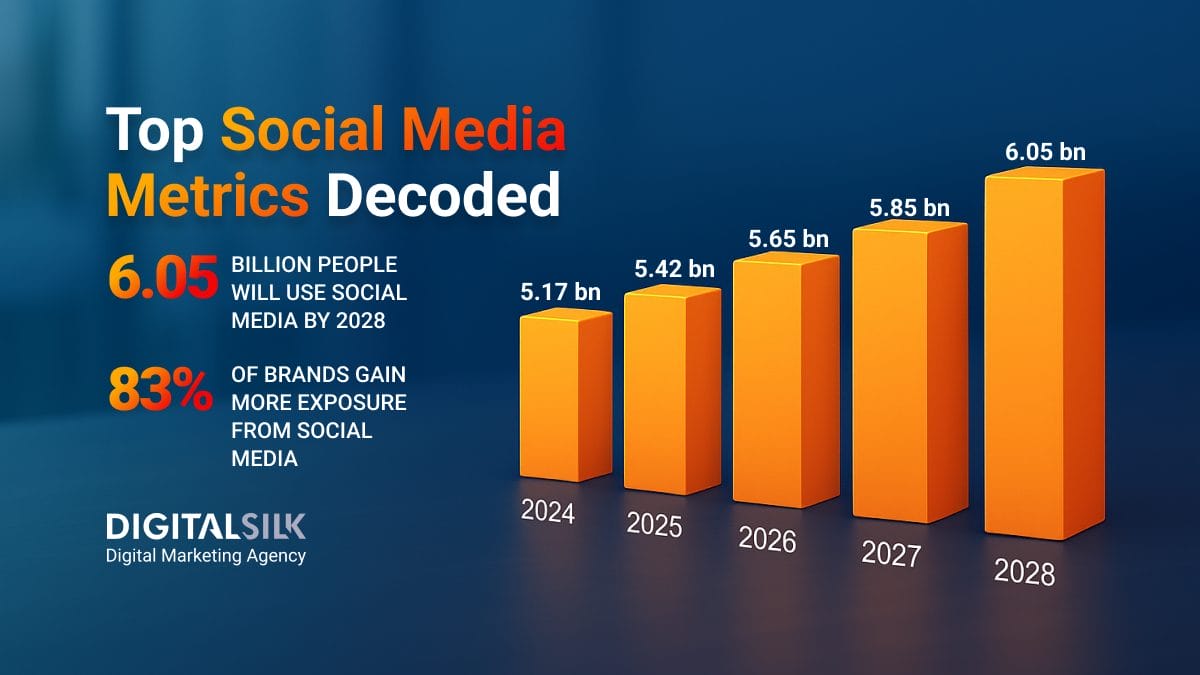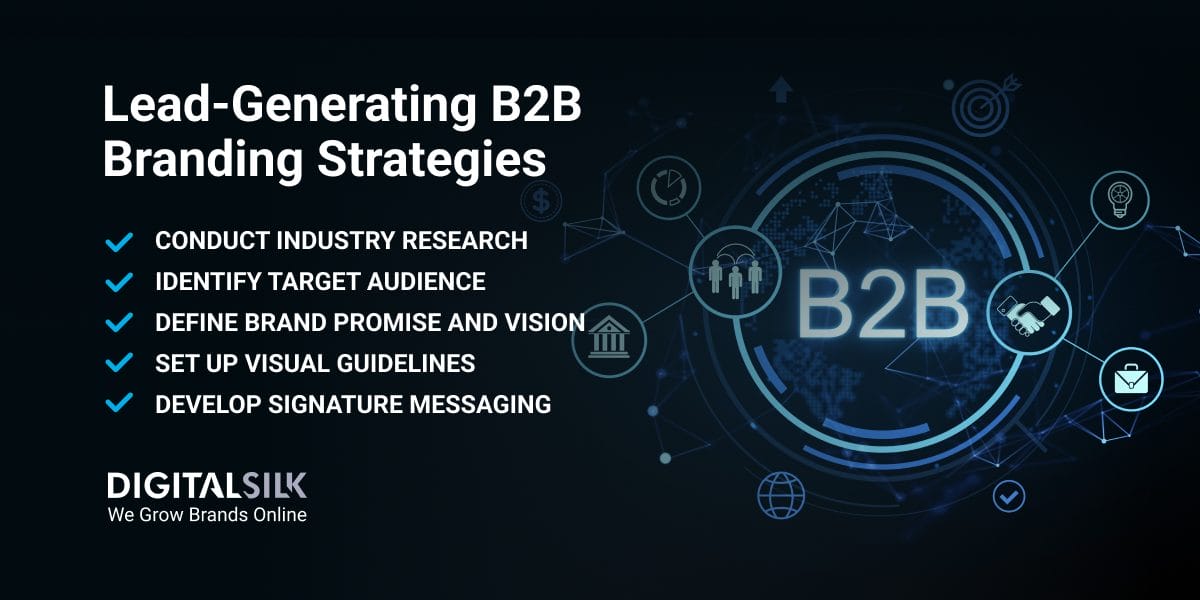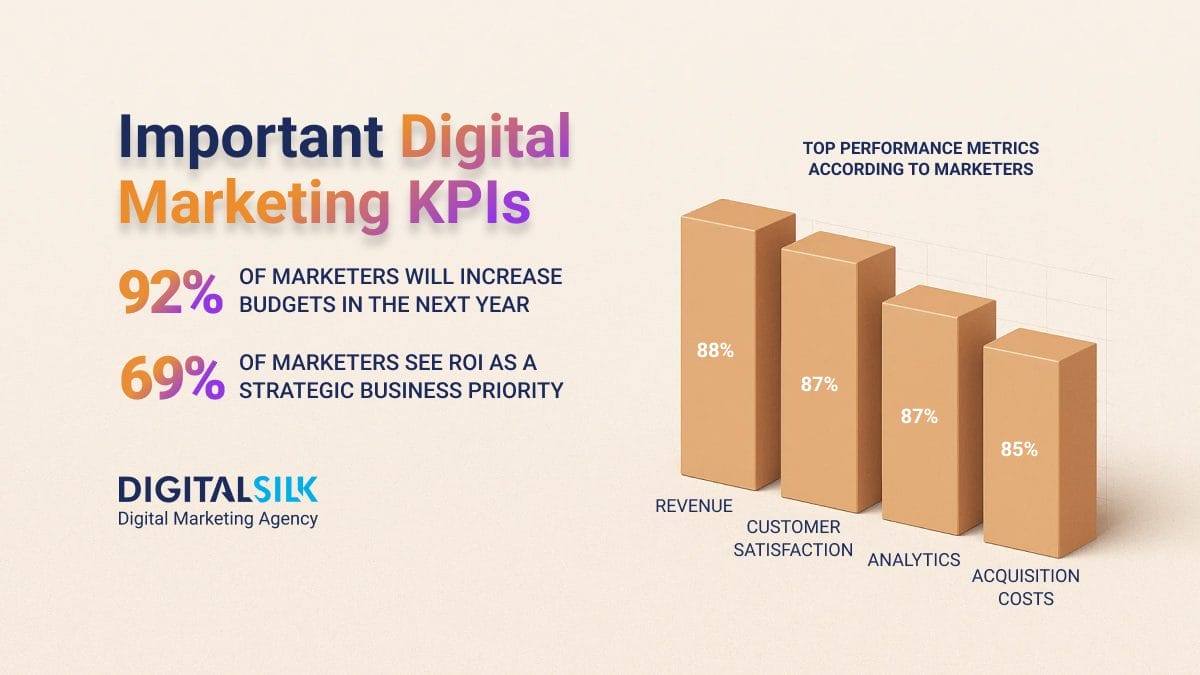Branding For Tech Companies: Key Highlights
-
Trust defines the tech brand: Ethics, transparency and purpose now matter as much as innovation.
-
Leadership is the brand voice: Visible, authentic executives shape credibility and influence.
-
Personalization builds loyalty: Data-driven storytelling beats one-size-fits-all messaging and connects with audiences.
What makes one tech company stay top of mind while another quietly blends into a crowded market?
With the technology hardware sector projected to grow from $729.6 billion in 2025 to $807.2 billion by 2028, differentiation is no longer a nice-to-have as competitors multiply and choices expand.
Branding now defines how tech companies build lasting credibility, earn trust quickly and stay relevant when innovation alone is no longer enough.
In this post, we’ll explore what branding for tech companies must deliver in 2026 to meet the sharper demands of buyers shaping the next wave of growth.
Top Branding Trends In The Technology Sector Shaping 2026
Tech companies are setting the pace for global brand value growth, driving $1.2 trillion of the $1.4 trillion total increase among the Top 100 most valuable brands and growing 45% year-over-year.
This momentum reflects more than product innovation, as it shows how tech leaders build brands people believe in, rely on and advocate for in fast-moving markets.
The trends that follow reveal how forward-thinking companies can use technology branding strategies in 2026 to stay relevant and build deeper connections.
1. Authentic Executive Branding
Today’s buyers want to know who is behind the technology they use and what those leaders stand for when no one is watching.
70% of consumers feel closer to a company when its CEO and leadership team are active on social media, showing that visibility at the top is no longer optional for brands that aim to build trust.
In a tech industry shaped by debates around AI ethics, privacy and social responsibility, personal branding for executives has become the clearest way to humanize innovation and build meaningful relationships with customers, investors and employees.
Authenticity is at the core of this connection, with 88% of consumers choosing to support brands they see as genuine and aligned with their values.
This is where executive branding drives real influence, helping leaders shape industry conversations, build reputational trust before challenges emerge and attract talent who want to follow leaders with a clear vision.
Personalized branding for tech leaders becomes meaningful when it reflects who you are and what you stand for, allowing you to:
- Spark conversations that influence the direction of the industry
- Build trust that protects the company’s reputation during difficult moments
- Rally teams behind meaningful work to connect bigger ideas and real-world outcomes
- Attract high-performing talent who want to work for leaders they respect
- Position the company as one driven by values, not faceless technology
To build a leadership brand that earns attention and respect:
- Audit your presence: Review your social activity, speaking engagements and media interviews and ask for candid feedback from people who know your leadership style.
- Clarify your message: Focus on the issues where your experience brings valuable perspective, whether that’s AI responsibility, product accessibility or sustainable growth.
- Show up consistently: Share your views where your audience is listening, from LinkedIn and podcasts to internal town halls and industry events.
- Talk about your process, not just your results: People relate to how you think through challenges and decisions, not polished highlight reels.
- Play the long game: Personal branding grows through consistent action and meaningful contributions, not one-off statements or reactive posts.
One of the clearest examples of personal branding in tech leadership is Steve Jobs.
His personal brand wasn’t built on product specs or press releases but on the way he spoke about creativity, simplicity and the intersection of technology and humanity.
People didn’t just buy Apple products, since they bought into his vision of making technology beautiful, intuitive and meaningful.
Why It Matters For Tech Leaders
- Executive branding builds trust before a sale is made
- Consistent presence drives talent acquisition
- Authenticity outperforms polish
2. Building Trust Through Ethical Tech And Transparency
For years, technology earned trust by default, but that dynamic is changing fast.
While 76% of people worldwide still trust the tech industry, in the United States trust has dropped to 60% in 2024, revealing a growing gap between global optimism and local skepticism.
Buyers, regulators and partners are demanding clearer answers about how technology works, what happens to their data and how companies handle the ethical risks of AI and automation.
For tech company branding strategies, trust and transparency are a part of what defines the brand itself.
Ethical practices, clear communication and accountability around AI bias, data privacy and social impact have become brand differentiators.
Companies that wait to communicate their values until after a product launch or a regulatory inquiry are already behind.
In 2026, tech executives will need to lead these conversations from the start, shaping public expectations before headlines and regulators do.
To build trust through ethical brand leadership, branding strategies for tech companies should:
- Make ethics public-facing: Move beyond internal guidelines and publish your approach to AI fairness, data privacy and security. Share how these values shape your products and services in ways people understand.
- Involve leadership early: Ensure legal, compliance and communications teams are part of product and platform launches from day one, rather than reacting when issues surface later.
- Be proactive about risks: Acknowledge the ethical challenges your company is working to solve and explain your approach. Silence leaves room for doubt.
- Communicate your values with clarity: Skip the jargon. Explain how your company balances innovation with responsibility in clear, human terms.
- Create visible accountability: Give customers, partners and employees ways to raise concerns and see how your company responds to them.
Why It Matters For Tech Leaders
- Proactive transparency is a competitive advantage
- Ethical clarity preempts regulatory risk
- Trust now defines brand loyalty
3. Hyper-Personalization In Brand Storytelling
Personalization in tech branding often stops at the surface, yet today’s buyers expect something far deeper.
While 61% of brands say they deliver personalized experiences, only 43% of consumers actually feel those efforts hit the mark.
The gap reflects a missed opportunity to create brand stories that speak to the real needs, goals and pain points of your audience.
Companies that get it right are 71% more likely to see stronger customer loyalty, showing that personalization is a long-term trust-building strategy.
To make hyper-personalization part of your brand strategy:
- Invest in deeper insights: Go beyond surface-level profiles and learn what your audience is focused on today, whether it is market shifts, growth targets or risk concerns.
- Frame your story around their ambitions: The most effective messages align your brand with what your audience wants to achieve, rather than starting with what you are trying to sell.
- Adapt quickly to change: Tailor your messaging to reflect recent events, industry changes or evolving customer needs, rather than waiting for your next campaign cycle.
- Use data to create relevance, not volume: Personalization is about the right message at the right time, not adding more content to your outreach.
- Continue the experience after the first contact: Make sure your personalization flows through sales conversations, demos and onboarding, creating a consistent and relevant experience.
Why It Matters For Tech Leaders
- Aligns brand with buyer intent
- Increases loyalty through relevance
- Turns engagement into long-term pipeline
4. AI-Powered Branding Strategies
More than 1.1 billion people are expected to use AI by 2031, making it one of the fastest-growing technologies in history.
AI has evolved from an automation tool to a key part of how companies tell their stories faster and with more relevance.
Businesses are using it to track buying signals, adapt messages in real time and create personalized content that speaks to what decision-makers care about today.
When used thoughtfully, AI helps communicate core brand elements and purpose more efficiently, but it can’t replace the human judgment and values that define what the message should be.
This rapid adoption also raises challenges that are easy to overlook. Trust drops by 144% when customers know AI is driving their interactions but can’t sense the human intent behind the message.
Internally, 70% of executives are worried that generative AI could weaken creativity and dilute brand voice, showing how technology can easily outpace the values and nuances that define memorable branding.
To use AI in a way that builds trust and connection:
- Let AI surface insights, but keep people in charge of meaning: Data can highlight opportunities, but leadership decides what story needs to be told.
- Adapt messaging in real time while keeping the voice consistent: Personalize experiences without losing clarity or purpose.
- Safeguard your brand’s persona: Regularly review AI-generated content and creative outputs to ensure they sound like your company, not like an algorithm.
- Be transparent when it matters: Let your customers and partners understand how AI improves their experience in ways that add real value.
- Keep creativity human-led: Use AI to support storytelling, but let ideas, empathy and judgment lead the way.
Why It Matters For Tech Leaders
- Speeds brand activation without losing voice
- Supports real-time personalization
- Requires human oversight to maintain trust
5. Purpose-Led Technology Brand Identity
94% of consumers value companies with a clear sense of purpose, proving that people want to support businesses whose values align with their own.
Purpose-led brands build long-term trust by communicating why the company exists and what impact it aims to make.
This purpose guides leadership decisions, shapes customer relationships and influences how the company takes part in industry conversations.
Salesforce is a clear example. Its focus on ethical AI, sustainability and workforce development reflects a commitment that extends beyond its products and defines how partners, employees and customers experience the brand.
To build purpose-led branding for tech companies:
- Define the values your company stands for and show how they guide your work
- Share stories that connect your purpose with the challenges and goals your audience cares about
- Keep your purpose active and visible as the company evolves
Why It Matters For Tech Leaders
- Purpose drives strategic alignment
- Connects internal culture with external impact
- Enables loyalty beyond product specs
6. Digital-First Brand Guidelines For Scalable Growth
With the U.S. accounting for 41% of global tech spending and North American investment projected to grow by another 6% in 2025, clarity and consistency in how your company presents itself will matter more than ever.
As teams scale and channels multiply, having flexible but precise guidelines helps ensure your message stays recognizable and effective.
Digital-first systems define how a company looks, speaks and behaves across every touchpoint.
This includes tone of voice, visual frameworks, motion rules, typography, color systems and usage guidance that hold up across product, marketing and partner efforts.
To build guidelines that scale with your business:
- Define a clear tone that reflects your position and speaks to your audience with intent
- Build a visual system that performs across formats, from UI to social content
- Create structured messaging and personas that guide how you show up in different settings
- Develop tools and templates that help teams apply the system consistently without slowing down
Why It Matters For Tech Leaders
- Ensures global consistency
- Enables efficient content production
- Scales brand across growing teams
7. Brand Loyalty Ecosystems With Tokenized Rewards
According to 62.1% of marketers, the main reason they’re satisfied with their loyalty programs is that they help build stronger engagement with customers.
This shift opens the door for brand-driven systems that reward involvement in ways that reflect what the company stands for.
Tokenized rewards assign value to brand-relevant actions using blockchain. Submitting product feedback, contributing to community forums or sharing expert content are all ways customers can engage more meaningfully.
When these actions are recognized through a reward system that reflects the company’s values, loyalty becomes a natural outcome rather than a transactional one.
To build a loyalty system tied to your brand strategy:
- Identify the behaviors that reflect meaningful engagement and connect them to value
- Design rewards with purpose, offering access, influence or recognition
- Keep the experience simple and transparent, so participants understand how and why rewards are earned
- Test and refine the system before scaling, using early feedback to shape a program that lasts
Why It Matters For Tech Leaders
- Drives engagement aligned with values
- Turns customers into advocates
- Uses blockchain to scale participation
8. Strategic Partnerships In Tech Niches
When two established tech companies align around a shared technical goal, the impact can go far beyond visibility.
These partnerships often set new standards, open markets and accelerate adoption by solving problems neither could address alone.
A strong example is the partnership between NVIDIA and Amazon Web Services (AWS).
Together, they’ve built GPU-powered EC2 instances, integrated NVIDIA tools into SageMaker and launched Project Ceiba, aiming to create the largest AI supercomputer in the cloud.
Their collaboration spans infrastructure, software optimization and advanced research, making cutting-edge AI more accessible to businesses and developers.
To make partnerships like this effective:
- Focus on solving specific technical challenges with shared value
- Develop joint solutions that are scalable and easy to deploy
- Support adoption with clear documentation and real-world examples
- Commit to long-term product and engineering alignment
Why It Matters For Tech Leaders
- Amplifies innovation credibility
- Unlocks access to new markets
- Accelerates product ecosystem adoption
B2C Vs B2B Tech Branding Differences
B2C and B2B tech branding follow different rules, shaped by how their audiences make decisions and what influences their trust.
Yet the two worlds are starting to overlap, as 90% of B2B organizations plan to expand their use of online marketplaces, adopting more consumer-like buying experiences.
Understanding where these differences remain and where they are starting to blur is key to building the right tech brand positioning for your market.
- Audience focus: B2C brands target individual consumers motivated by lifestyle needs and price sensitivity, with 62% of consumers willing to switch brands for a lower cost. B2B brands speak to buying committees that prioritize peer recommendations and product performance over price alone.
- Messaging style: Consumer-facing messaging is simple and emotion-based, helping people connect quickly and instinctively. Enterprise messaging focuses on clarity, proof and practical outcomes that solve real business problems.
- Sales cycles: B2C purchases are designed for speed, moving buyers from awareness to action in a single interaction. B2B sales cycles are longer and require multiple touchpoints that build trust with decision-makers.
- Channel mix: Brands selling to individuals scale fast through broad digital channels like social and paid search. Companies targeting business buyers use thought leadership, direct outreach and increasingly, online marketplaces where convenience is becoming expected.
- Success metrics: Consumer-facing brands track reach, clicks and conversions. Business-focused companies measure lead quality, sales velocity and retention to reflect long-term growth.
What Factors Influence The Way A Business Carries Out Its Brand Promise
A brand promise is only meaningful if every part of the business delivers on it consistently.
This is where tech brand positioning becomes visible, not through campaigns but through leadership decisions, customer experiences and employee actions.
The following factors determine whether your brand promise holds up when it meets the real world:
- Executive leadership alignment: Brand trust starts at the top. Leadership teams that stay aligned on priorities and speak with one voice build clarity across the business. Regular conversations about what is working and what needs to change make the brand promise something employees and customers can see, not guess.
- Customer experience consistency: Buyers judge your brand by the last product issue, service interaction or checkout experience. Companies that maintain consistent brand experiences across channels see an average revenue lift of 23%.
- Employee brand advocacy: Employees shape how your brand is experienced beyond your official channels. Encourage teams to share wins and personal stories in ways that feel natural, whether on social media or in daily work chats.
- Market positioning and competition: Tech brand positioning depends on understanding both known competitors and rising disruptors. Keep a real-time view of key names and unexpected players solving problems your teams may have overlooked.
- Brand governance and guidelines: Strong brands balance consistency with flexibility. Create clear brand principles that help global teams stay aligned while allowing local nuance where it makes sense. When brand experience and customer experience improve together, companies can achieve up to 3.5x revenue growth and drive stronger customer loyalty.
Measuring Branding Success In A Tech Enterprise
Measuring brand performance remains one of the toughest challenges in tech, yet it drives long-term growth that short-term tactics alone cannot sustain.
70% of marketers are prioritizing performance marketing over brand building, missing the opportunity to make both work together.
Digital branding for tech companies should fuel pipeline growth while shaping the market’s perception of the business.
Here’s how you can measure it effectively:
- Assess key performance indicators (KPIs): Focus on the metrics that shape influence and trust. Track share of voice, brand sentiment and executive visibility across industry conversations. Then tie those signals directly to pipeline, retention and partner engagement to prove brand health drives market impact.
- Brand equity measurement in emerging markets: Growth markets bring opportunity and exposure. Use local market studies and social listening to monitor how your brand is perceived, especially during launches or post-deal integration.
- Tracking audience engagement in real time: Monitor audience reactions across marketing channels, support queues and product communities to adjust campaigns before small issues turn into missed opportunities.
- Aligning brand metrics with business objectives: You should track brand performance alongside revenue, profitability and talent metrics. Define how brand KPIs contribute to pipeline growth, customer loyalty and employer reputation to show their impact where it matters most.
From Brand To Backend: Embedding Identity Across Systems
Branding for tech companies doesn’t stop at message and design. It must integrate with the platforms that drive revenue, engagement and governance.
In 2026 and beyond, leading enterprises are:
- Connecting CRM and brand systems to personalize messaging and track buyer intent across the funnel (e.g., Salesforce, HubSpot, Marketo).
- Operationalizing brand trust by aligning AI tools and customer data flows with General Data Protection Regulation (GDPR), California Consumer Privacy Act (CCPA) and System and Organization Controls 2 (SOC 2; relevant for SaaS and tech companies offering cloud-based services.) compliance.
- Embedding brand voice into sales, onboarding and support workflows through CMS, chatbots and help hubs.
Digital Silk supports enterprise-grade branding rollouts that align with your existing tech stack, so your brand is seen and seamlessly integrated.
Create Branding For Your Tech Company With Digital Silk
Building a tech brand in 2026 means creating real connections, earning trust through transparency and using personalization and AI with intent.
Companies that align their brand strategy with business outcomes will shape conversations that drive both loyalty and growth.
Digital Silk uses in-depth industry and market research to shape tech company positioning and create digital strategies that drive differentiation and long-term growth.
As a professional branding agency, our services include:
- Branding solutions
- Rebranding services
- Brand identity
- Logo design
- Custom web design
- Digital marketing
Our dedicated team offers proactive and consultative project management, backed by transparent communication and measurable results.
Contact our team, call us at (800) 206-9413 or fill in the Request a Quote form below to schedule a consultation.
"*" indicates required fields


